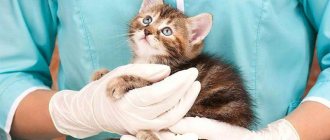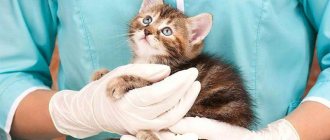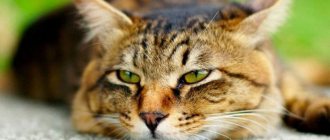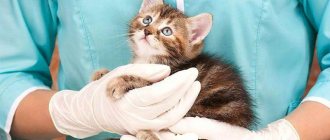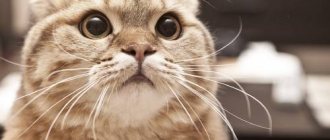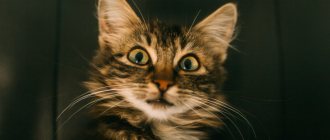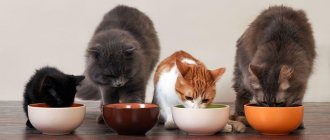How does the condition manifest?
In cats, periods of increased activity are usually followed by apathy and drowsiness. It is difficult for owners to understand why and at what exact moments this happens. Therefore, a situation where a cat is lethargic, hardly eats and sleeps a lot, is alarming.
The owner should clearly know that poor appetite and less active behavior do not always indicate an animal illness. And the veterinarian is sometimes unable to understand why the cat is lethargic. The observations of an attentive and loving owner are extremely important here.
The main signs of cat health, in addition to good appetite and good spirits, are:
- shiny and smooth coat;
- pink and slightly moistened mucous membranes;
- cold and slightly damp nose (normally, during sleep it can become warm and dry);
- pulse, respiratory rate and temperature are within normal limits;
- absence of excessive discharge from the eyes, ears and nose, plaque in the mouth, salivation and unpleasant odor from the mouth and ears.
It is important! The normal duration of rest for a cat per day is 12-14 hours or more.
How much water should a cat drink daily?
An adult, healthy individual needs to consume approximately 40-50 milliliters of fluid per kilogram of body weight daily. The amount of moisture in the feed is also an important point. For example, a pet weighing 4.5 kilograms requires approximately 200 ml of liquid. If a cat eats 170 grams of wet food daily (moisture content 80%), it covers more than half of the daily water requirement, receiving 135 ml of liquid with the food. If he eats only 70 grams of dry food (moisture content 9%), he needs to drink another 180 ml per day. The activity level of pets should be taken into account. The more active your pet is, the more fluid it needs. Also, if the air temperature outside or indoors is above 20 degrees, the need for fluid consumption increases. It is worth noting that sometimes a different drinking regime may be required. So, for certain diseases or after operations, you must strictly follow the veterinarian’s recommendations. Stress factors, for example, a change of place of residence, unknown people at home, a neighbor's cat, affect the behavior of four-legged friends. Often cats drink less in such situations. Let her get used to the new life situation, observe her behavior. The required amount of fluid for the body also depends on age. A kitten's young, growing body requires more fluid. And in old age, this need decreases. It is completely normal for an older cat to drink less than normal.
Possible causes of lethargy in healthy animals
Often there are reasons why a cat is lethargic, sleeps all the time and eats little, but it is better to understand each of them in order.
Stress
It is not uncommon for a cat to eat poorly and sleep a lot after a serious nervous shock.
Cats are very sensitive animals, so they have many causes of stress:
- travel by car;
- the arrival of a new family member or pet in the house;
- change of owner;
- repair or rearrangement of the house;
- visit to the veterinarian;
- change of place of residence by owners;
- lack of attention from the owner;
- pain;
- recent surgery;
- visit of guests;
- bathing and other hygiene procedures;
- changes in daily routine;
- the appearance of new and unusual objects in the house;
- first time on the street.
Usually cats cope with this situation quite well without medical help, but they really need the support of their beloved owner. However, in some particularly susceptible cats, stress lasts for quite a long time and can even be harmful to health.
The main physiological signs of nervous shock in a cat:
- urinary incontinence;
- rapid breathing;
- diarrhea or constipation;
- increased cleanliness (a cat can lick itself until bald spots appear on its fur and irritation on the skin);
- yawning too often;
- urinating in inappropriate places (the cat is marking its territory).
It is important! If, as a result of stress, the cat’s behavior does not return to normal for a long time, it is better to show the animal to a doctor. After all, nervous shocks can negatively affect his health and lead to the development of diabetes, skin diseases and disturbances in the functioning of the cardiovascular, digestive and genitourinary systems.
Change of feed
Often the cause of a lethargic state and refusal to eat is a change in diet (for example, switching from natural food to ready-made food and vice versa).
In this situation, you should return the cat to its previous food and treat it with some treat. Then the restoration of appetite and a cheerful state will occur very quickly.
Hot weather
Cats do not have sweat glands. They do not know how to cool themselves by opening their mouths, like dogs. Therefore, in the heat, to protect themselves from overheating, furry pets try to lie more in cool places. In addition, they begin to eat less so as not to waste energy on burning calories received with food.
Age
Over time, many owners begin to worry that their once active and nimble cat has become lethargic, eating almost nothing and lying around all the time. This is easy to explain: older cats no longer have as much energy for play; they sleep longer and more soundly than young animals.
If an elderly pet is lethargic, eats without appetite and sleeps a lot, but at the same time drinks water and has the above signs of a healthy cat, then there is no need to worry. However, an older cat should be regularly taken to the veterinarian for examinations to prevent the development of diseases.
Kittens spend almost 90% of the day sleeping until they reach two months of age. If the kitten is lethargic, plays little and eats poorly during periods of wakefulness, then the best solution is a trip to the veterinarian.
It is important! The maximum duration of healthy fasting for kittens is 1 day, for young cats and middle-aged pets – 3 days, and for “old people” – 2 days. If after this time the cat still does not start eating, you need to consult a doctor as soon as possible.
Pregnancy
In the early stages of pregnancy, many cats, like people, suffer from toxicosis. They become lethargic, try to move less and more carefully, sleep more and often refuse to feed.
If a cat was mated 3-4 weeks before this condition, then after another 5-6 weeks you can expect an addition to the cat family.
How to help your pet
The best help for your pet is to see a doctor. An exception may be situations when you are absolutely sure that such a condition is caused by stress. For example, a recent move to a new place of residence or the arrival of a new pet or family member. But even here your cat needs help. There are special medications that will help the animal calm down faster and enter the usual rhythm of life (for example, Kot Bayun infusion, collar or Feliway spray).
Feliway is a specially developed pheromone for cats that helps normalize the pet’s behavior in a stressful situation.
Before visiting the veterinarian
Before visiting the veterinarian, the owner can independently take measures to somehow alleviate the pet’s condition:
- Ensure peace and quiet, remove light irritants (dark windows).
- If possible, isolate from other pets (if there are any in the house) in case of an infectious disease.
- Place the pet on a clean bedding, not too soft, but comfortable.
- Place clean water and some of your favorite food next to your pet.
- You can force the cat to drink from a syringe without a needle (2-3 ml every half hour). This must be done if your pet has diarrhea or vomiting, or if the sick person is a kitten.
- If there is grass specially grown for your pet, offer it.
You cannot give any medications on your own without the advice of a veterinarian. They can smooth out the symptoms, and it will be more difficult for the doctor to understand the true cause of the cat’s ill health.
You can call your veterinarian by phone for advice. He will not make a diagnosis over the phone, but he will be able to give some professional recommendations that can help the animal before arriving at the clinic.
I always have a piece of paper pinned with a magnet on my refrigerator with the veterinarian’s number (it’s also written into my phone’s contact book). I usually call to find out a convenient time to accept my pets (so as not to sit in line later). But one day I needed a consultation when the cat was vomiting (she was poisoned by something, as it turned out later, but we did not identify the exact source, because she was walking in the yard and could have eaten anything). The clinic was no longer open (it was evening), and over the phone the doctor advised me to feed the cat Enterosgel and forcefully give her water. This way we were able to hold out until the morning, when the cat was able to receive help at the clinic (including putting on an IV).
After receiving doctor's orders
After the veterinarian has made a diagnosis and prescribed treatment, you should strictly follow all his recommendations. Do not hesitate to clarify all the details regarding taking medications.
Never stop treating your pet before the time prescribed by your doctor, even if it seems to you that he has completely recovered. Infectious diseases require a full course of therapy.
Perhaps the doctor will advise changing the diet, making it more gentle on the pet’s gastrointestinal tract. Special lines of well-known brands of cat food may be suitable, for example:
- Gastro Intestinal from Royal Canin;
- Vet Life Cat Gastrointestinal from Farmina;
- PRO PLAN Veterinary Diets EN Gastrointestinal;
- Hill's Prescription Diet Feline i/d.
Additional recommendations
Following these recommendations will help your cat recover faster:
- A calm environment will help your cat get out of stress. You should not force your pet into games and communication.
- If your pet refuses the new diet, go back to the old one. If this is not possible, look for other cat food options (some animals refuse certain brands, so trial and error is the only way to find the right food).
- Ecto- and endoparasites are destroyed using special preparations. There is no need to use them before visiting a doctor, but in the future it is always better to use them for prevention.
- Inflamed gums can be treated with a solution of chlorhexidine or manganese (faint pink). This procedure is carried out twice a day. A piece of gauze is soaked in a medicinal solution and gently pressed onto problem areas of the oral cavity without applying pressure. Depending on the affected area, you can also use cotton swabs, precisely treating the desired areas.
Possible pathological conditions
If the cat has been lethargic for several days, sleeps a lot, drinks and eats poorly, and can barely walk, the owner should under no circumstances let the situation take its course. Such a condition in the pet’s body most likely signals the development of a serious disease. The cat must be shown to a doctor in the next few hours.
Anemia
Anemia occurs when a cat's body produces less red blood cells and hemoglobin.
In addition to the fact that with anemia, a cat is lethargic and sad, it also exhibits other signs of this unpleasant disease:
- the nose becomes lighter;
- mucous membranes acquire a bluish tint;
- blood pressure decreases;
- the pulse is sometimes rapid, sometimes rare;
- breathing accelerates, shortness of breath appears;
- the fur becomes dull and may fall out;
- clear discharge appears from the nose.
Diseases of the cardiovascular system
If the cat eats poorly and constantly sleeps, is lethargic, tries to walk less - these may be signs of the development of a disease of the cardiovascular system.
Your pet may be bothered by fluctuations in blood pressure.
It is important! Normally, blood pressure in cats can “jump” from 105/65 to 135/95 mmHg.
With high blood pressure, furry couch potatoes experience:
- lethargy;
- decreased vision (while moving, the cat may bump into furniture and other objects);
- rapid pulse;
- dilated pupils;
- redness of the eyes;
- sometimes vomiting;
- in some cases - nosebleeds.
With low blood pressure, the pet refuses to eat due to nausea, sleeps a lot, its pulse slows down, and the cat may even lose consciousness.
In acute heart failure, the animal is also lethargic, its breathing becomes difficult, shortness of breath and bluish discharge from the nose appear.
An important symptom of the development of heart disease in a cat is its characteristic posture in a relaxed state. She usually stands with her front legs spread wide. This makes it easier for her to breathe.
Gastrointestinal diseases
Often the cause of a pet's lethargic and sleepy state and his refusal to eat are diseases of the gastrointestinal tract.
With gastrointestinal pathologies, a cat may exhibit symptoms:
- bloating;
- stools that are very dark, almost black, or mixed with blood and mucus;
- belching;
- constipation;
- flatulence.
Diseases of the urinary system
The development of urinary system diseases in cats, in addition to a lethargic state and lack of appetite, is accompanied by symptoms:
- too frequent or infrequent urination, or its complete absence;
- constant pain when urinating;
- the appearance of blood or pus in the urine;
- sweetish smell from the mouth;
- lower back pain;
- extremely unpleasant odor of urine.
To reduce pain at least a little, the animal lies down almost all the time, does not drink or eat.
It is important! If your pet has a blockage in the urethra, without medical attention he may die within 3 days.
Infectious diseases
In many cases, a cat’s lethargic behavior, refusal to feed and staying in almost constant sleep indicate an infectious disease.
Such diseases are extremely dangerous for cats and require immediate medical attention. The owner must remember that the life of his pet is literally counted in minutes.
The most dangerous infectious diseases that cause cats to become very lethargic are:
- Leptospirosis: Caused by the bacterium Leptospira. The disease affects almost all cat organs and is very dangerous for humans;
- Calcivirosis is a viral disease that affects the respiratory tract. It occurs mainly in cats under 2 years of age, but sometimes in older individuals;
- FIV is feline viral immunodeficiency: an extremely dangerous disease that affects the immune and nervous systems. Only representatives of the cat family, including wild representatives, can become infected with it;
- Panleukopenia (popularly called feline distemper) is a deadly disease that develops very quickly. It affects the cardiovascular, digestive and respiratory systems of the cat and is accompanied by intoxication of the entire body;
- herpes virus infection (another name is rhinotracheitis): caused by the feline herpes virus. Affects the respiratory and visual organs. If the animal is weakened by other diseases and does not receive proper treatment, the infection can lead to death.
The main signs of a cat becoming infected with a dangerous infection:
- lethargy and apathy;
- lack of appetite;
- high body temperature (above 40°C);
It is important! Normal body temperature in adult cats is 38-39°C, in small kittens – 38-39.6°C, in sphinxes – 38-41.5°C.
- labored breathing;
- cough and wheezing;
- vomit;
- foul, greenish diarrhea;
- bloody discharge from the mouth, nose, ears, eyes;
- soreness in some parts of the body.
Intoxication
Poisoning of the body (intoxication) in cats, in addition to lethargy and refusal to eat, is indicated by:
- diarrhea;
- vomit;
- increased salivation;
- increase or decrease in body temperature;
- redness or blueness of mucous membranes;
- constant feeling of thirst;
- convulsions and so on.
If you suspect poisoning, you should try to induce vomiting in the cat so that the body can at least partially get rid of toxins, and then take it to the veterinarian.
However, if more than 2.5 hours have passed since the poisoning, it is better to transport the pet to a veterinary hospital as soon as possible. After all, during this time, toxic substances have already spread throughout the circulatory system throughout the body.
In order to protect your furry pets from intoxication, you need to know its main causes:
- stale or poor quality food;
- contaminated drinking water;
- bites of snakes and poisonous insects;
- helminth infection;
- bacterial and viral infections;
- violation of hygiene rules when keeping animals;
- eating poisonous plants, fertilizers, chemicals;
- uncontrolled use of medications;
- individual intolerance to certain components of feed, hygiene products, etc.;
- exposure to toxic fumes from paint and varnish products.
Parasites
The cause of lethargic behavior and drowsiness can be a cat’s infection with external and internal parasites (fleas, ticks, worms).
Flea and tick bites cause itching and pain in cats. As a result, due to constant scratching, wounds appear on the skin, and the hair begins to fall out.
A cat with ear mites often shakes its head and scratches its ears, in which a lot of wax with an unpleasant odor can be found.
Cats infected with worms are often lethargic. Other signs of the disease:
- bowel disorder (diarrhea or constipation);
- vomit;
- itching and irritation in the anal area;
- temperature increase;
- bloating;
- the presence of eggs and particles of worms in the feces.
If external or internal parasites are detected in your pet, you need to begin exterminating them as soon as possible. The veterinarian will prescribe the medications.
The fight against parasites is very important, because they are quickly transmitted to both other animals and humans.
Additional recommendations
Following these recommendations will help your cat recover faster:
- A calm environment will help your cat get out of stress. You should not force your pet into games and communication.
- If your pet refuses the new diet, go back to the old one. If this is not possible, look for other cat food options (some animals refuse certain brands, so trial and error is the only way to find the right food).
- Ecto- and endoparasites are destroyed using special preparations. There is no need to use them before visiting a doctor, but in the future it is always better to use them for prevention.
- Inflamed gums can be treated with a solution of chlorhexidine or manganese (faint pink). This procedure is carried out twice a day. A piece of gauze is soaked in a medicinal solution and gently pressed onto problem areas of the oral cavity without applying pressure. Depending on the affected area, you can also use cotton swabs, precisely treating the desired areas.
Other pathologies
In addition to the listed pathological conditions of cats, accompanied by lethargy, drowsiness and loss of appetite, the following painful conditions also occur:
- disturbances in the functioning of the endocrine system.
For example, after sterilization or childbirth due to hormonal imbalance, cats become lethargic and inactive.
Pets suffering from diabetes also do not want to move too much. In addition, such cats are constantly thirsty, eat a lot or very little, and often go to the toilet. They experience weight fluctuations, their vision deteriorates, their stomach enlarges, their muscles weaken;
- oncological diseases.
One of their symptoms in cats is a lethargic state. Changes in the pet’s well-being are clearly visible: the cat hardly eats, lies down all the time, vomits, and experiences internal bleeding. Such animals have very unpleasant breath, and upon visual examination, swelling and ulcers can be detected on the body;
- diseases of the musculoskeletal system.
Even an inexperienced owner can easily recognize them. With arthritis, dislocations, sprains, osteochondrosis, fractures and other problems, animals become lethargic, try to eat and move less. Cats' affected joints swell, they limp, rarely sharpen their claws and wash themselves. All movements cause them pain;
- complications after surgery.
Usually, in the first three days after the intervention, cats are very lethargic. This condition, in the presence of appetite and thirst, is considered normal.
But, if the animal’s temperature rises, blood or pus begins to ooze from the wound, vomiting or constipation often occurs - you need to contact the clinic as soon as possible. After all, these can be dangerous symptoms of suture dehiscence or suppuration, or the formation of a hernia.
What to do if a small kitten cannot eat and drink on its own?
It happens that a little purr is separated from its mother cat too early. Experienced breeders of purebred animals give the kitten to new owners no earlier than 3 months of age, when it already knows how to eat on its own and is accustomed to a certain food. If the kitten was taken away from the cat when it was very tiny or the baby was simply found on the street, it is likely that he simply has not yet eaten anything other than his mother’s milk. The baby doesn't know how to lap from a bowl. Moreover, he has no habit of drinking water.
Such a cat will have to be fed milk from a pipette or bottle with a nipple. Moreover, it is recommended to use a special cat's milk substitute. Then you can gradually teach the kitten to lap from the bowl and eat wet food. A good way is to offer the baby food from your hand, sometimes this helps kittens start eating new food.
When refusal to eat and drink becomes a dangerous symptom
If the forced fasting is prolonged or the cat does not drink water at all, hides in a dark corner, looks unkempt, “greasy”, does not even try to wash, has a fever, vomiting or diarrhea - these are alarming signs indicating serious disturbances in the functioning of the body. . You need to urgently take your cat to a veterinary clinic, because such symptoms may indicate very dangerous diseases, injuries or damage to internal organs.
The causes of such conditions may be:
- Heavy food that is difficult and takes a long time to digest;
- Food poisoning;
- Intoxication;
- Worm infestation;
- Infectious diseases;
- Foreign body in the digestive system;
- Volvulus;
- Benign or malignant neoplasms, metastasis, cancer intoxication;
- Kidney or liver failure;
- Internal bleeding;
- Severe injuries to internal organs (beatings, falling from a height, being run over by a car, etc.);
- Diabetes;
- Rabies.
A small kitten cannot go hungry or drink liquids for too long. This weakens an already fragile body, so even a day of fasting can be a health risk for him. A young and strong animal can “go on a diet” for three to five days, provided that it constantly drinks water in sufficient quantities.
If the cat does not want to look at any liquid, you need to consult a veterinarian. An older cat may eat irregularly and have poor appetite, especially if it has chronic digestive problems. However, too long a lack of appetite cannot be considered the norm in this case either.
If there are natural causes, you need to eliminate the trigger that triggered the loss of appetite:
- Choose quality food;
- Establish communication with the cat, caress him, show that everyone loves him;
- Change the water more often and do not add a lot of dry food. It is better to do this more often, but in small portions;
- Do not allow your cat to rummage through trash or eat scraps;
- Keep medications, cosmetics and household chemicals away from her;
- In extreme heat, place the animal in a shaded, cool place. In case of severe overheating, heatstroke or sunstroke, give your pet a drink, moisten the fur with water, and place a damp cloth on the head.
If the cat’s condition is of concern, it is better to play it safe and go to the clinic to eliminate negative consequences and deadly diseases.
Authors of the articles: Belanta Clinic team
If a lethargic cat does not eat or drink, what should I do?
Often, a pet's refusal to eat can frighten the owner. When a cat is lethargic and spends most of its time in one position, this is certainly not a good sign. If the cat does not eat or drink and only sleeps, it is necessary to understand the reasons for this behavior, because it is quite possible that your cat is sick and needs to be treated.
What does it mean for a pet to refuse food and drink?
There are situations when a cat does not eat or drink for several days, but only sleeps for no reason. If a cat does not eat and therefore loses its appetite, this can be called anorexia. However, an animal's appetite is determined by psychological factors, unlike hunger, which is a physiological phenomenon.
There can be many reasons why a cat does not eat for several days and only sleeps. Often, a kitten does not eat because some harmful processes have begun in its body, that is, a disease is emerging. As a rule, if a cat is lethargic, does not even drink water for a long time and lies in one place for most of the day, then this indicates diseases of the stomach or other main organs. After all, when experiencing severe pain, the animal will not have time to eat.
Note that if the pet is very lethargic during the day and does not even drink water, this may indicate the first heat. Owners think their pet is sick, but this is not the case. In this case, the animal begins to get acquainted with new natural urges, and this can lead it to confusion. This behavior and refusal of water and food may subside within a few days and then return to normal.
If the kitten does not eat anything for a long time and does not even drink water during the day, he is lethargic and does not want to do anything, then your pet is probably sick. Often infectious diseases such as worms are the cause of lack of appetite. To prevent your pet from losing weight and being lethargic, it is necessary
Source
We took him to the veterinarian, and based on palpation they suggested kidney problems. The temperature was 40.5. They injected an antipyretic (analyte mixture)
I wanted to put a catheter on the cat on the 1st and start making a nutritional drip (so as not to torment me with syringes and hunger), the 1st doctor said that there was no need, the 2nd doctor didn’t say anything at all, today the 3rd doctor agreed with me about the need to install a catheter and nutrition. IVs, and 1st still thinks that this is not necessary.
Today we took the first injection of Heptral in the morning at home, 1.3 ml, I vomited white liquid (in the evening we reduced the dose to 0.8 ml after the injection there was no vomiting)
In the evening, I vomited several times with a yellow liquid with foam (the liquid has no bile odor, there is a faint smell of medicine)
Rules, paragraph 5: Post test results in the form of scans or photos. The analysis form must fit on the scan or photo ENTIRELY, and not just those indicators that differ from the norm.
I didn’t catch it, for prevention of what? I don’t understand at all what such a tag is doing in this community, although this can probably be explained.
I am not a doctor. But the only thing I can advise is to already contact (maybe another?) _one_ doctor who can finally make a diagnosis and treat for a specific one. Running from person to person, from appointment to appointment is a waste of the cat’s time and energy for something unknown, and whether or not this time exists, no one knows.
Not vet. Check your teeth. Mine couldn't eat because of tartar. This is where the inflammation came from - the gums, abdominal organs, etc. Of course, it is necessary to treat the inflammation, but first remove the cause.
The diagnosis is to understand between the possibility of intestinal obstruction and the case of acute viral leukemia of cats, both diseases fit the picture and tests.
Exclude obstruction by carefully palpating the abdominal cavity and examining the oral cavity
Source
How do cats age, at what age does the process begin?
A cat's life is shorter than a human's. There is an opinion that 1 year of a cat’s life corresponds to 7 years of a human’s life. However, if we compare the age at which these animals reach sexual maturity and their total life expectancy, which averages 15 years, it becomes obvious that a linear relationship is not traceable in this case.
An old cat can be considered from the age of 11–12 years. After 15, the pet develops diseases characteristic of old age. In the course of studies of the gastrointestinal tract of these animals, it was revealed that the decline of their individual functions begins already by 7–8 years. That is why these numbers are indicated on feeds intended for aging animals.
Aging is a set of destructive changes in cells and tissues that increase the risk of cell death, subsequent tissue destruction and, ultimately, the death of a living being. The peculiarities of this process depend on many factors: heredity, developmental defects, diseases, and the influence of external unfavorable factors. In cats, the processes of withering of the body are accompanied by a decrease in interest in food, physical activity, speed of mental reactions, ability to adapt to changes, and muscle mass.
How to make a scratching post for a cat with your own hands at home: 6 models of scratches from improvised means
This process in itself is not a disease, but it leads to deterioration of the internal organs, depletion of the body's reserves, and decreased regeneration, making the animal more susceptible to disease. According to research, pathologies associated with aging develop in felines at approximately 11.9 years (± 2).
In an aging pet, the skin becomes less elastic, the functions of the immune system weaken, and its reaction to the influence of negative factors slows down. His body changes, which is associated with a decrease in muscle mass and disruption of the digestive system in terms of absorption and assimilation of nutrients.
As cats age, their perception of taste and smell becomes dull, and the body's ability to regulate glucose levels deteriorates. Older animals also decline in activity and cognitive function, so they sleep much longer than when they were young and are less able to adapt to change. The decline of the cat's body can be accompanied by serious deterioration and even complete loss of vision and hearing.
Best articles: Cat family - characteristics, representatives, classification and photos
The most common problems faced by owners of older pets:
- Urinary incontinence. The first thing to do in this situation is to examine your pet to rule out urolithiasis. If he is clinically healthy, you will have to focus on more thorough animal care.
- Constipation or diarrhea due to impaired intestinal motility. To normalize the process of emptying it, a diet is required, which will be developed by a veterinarian.
- Graying of whiskers and fur on the body or face.
- Deterioration of coat condition. It can become oily or, on the contrary, dry, take on an unkempt, disheveled appearance.
- Brittleness or thickening of the nails.
- Discoordination of movements. Older cats move stiffly, lose the ability to jump, and skid when turning.
Let's summarize: what to do if the kitten does not eat or drink
First of all, you need to carefully observe the animal. If there are no other alarming symptoms, you can try changing the food, bowl, and minimizing stressful situations.
But if the baby’s condition causes concern, and the owner cannot figure it out on his own, there is no need to waste time asking questions on various forums. You need to immediately take the animal to the veterinarian or invite a doctor home. An in-person examination and tests will help identify the exact cause of the ailment and prescribe treatment in a timely manner. If the fears are not confirmed, a professional doctor will give recommendations on proper nutrition. And just making sure your pet is healthy is never a bad idea.
Useful links:
The cat is hot and lethargic: what to do
If the pet's body temperature is higher than normal (38-39.5 °C), he has a hot, dry nose, the cat is lethargic, apathetic, trembling, coughing and/or sneezing, perhaps there is an inflammatory process inside him, for example, a cold. Usually the pet’s body copes with this problem on its own within 24 hours, so during this period it is recommended to provide the cat with rest and plenty of fluids.
After the cat feels better the next day, you can give him a light warm broth, and then gradually introduce his usual foods. If an elevated rectal temperature persists for more than 48 hours, you should immediately contact a veterinarian to prevent dehydration. If there is such an opportunity, it is better to invite a doctor to your home so as not to torment the sick animal with transportation.
A high temperature in a cat is most often due to a cold.
If your cat has a fever, hot ears and a dry nose, this could be a sign of ear mites.
In this case, it is recommended to carefully examine the pet’s hearing organs for the presence of plaque, dirt, liquid discharge or squelching, or an unpleasant odor. If the listed signs are identified, you need to visit a veterinary clinic, where a specialist will take biomaterial from the cat’s ear and conduct an analysis. Based on the result, the veterinarian will determine the severity of the infection and prescribe the required treatment.
Based on the result, the veterinarian will determine the severity of the infection and prescribe the required treatment.
An increase in body temperature may be a reaction to lichen, which is detected upon careful examination of the pet in the form of bald patches. Treatment of lichen depends on its stage, intensity of infection and the cat’s immunity.
Therefore, when you notice the first symptoms (bald patches, itching, lethargy, increased body temperature), it is important to contact a clinic, where, using a special lamp, they will identify the nature of the lichen and prescribe an effective treatment
The cat twists his bruised paw
The cat is lethargic and sleeps a lot - this could be due to bruises, dislocations or fractures, which are the most common cause for this condition in cats. During sleep, healing processes are accelerated, and pain is practically not felt. To rule out a fracture, it is necessary to take an x-ray in the clinic.
Lethargy and drowsiness of a cat for a short period of time is not a cause for concern. The pet needs to be given time to rest and gain strength. If a lethargic, apathetic state lasts for several days, is accompanied by a number of symptoms, and the cat looks tired and thin, you need to contact a veterinary clinic for a consultation, where an accurate diagnosis will be established based on a visual examination and test results.
